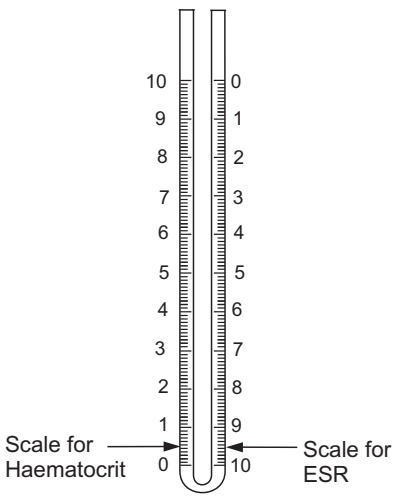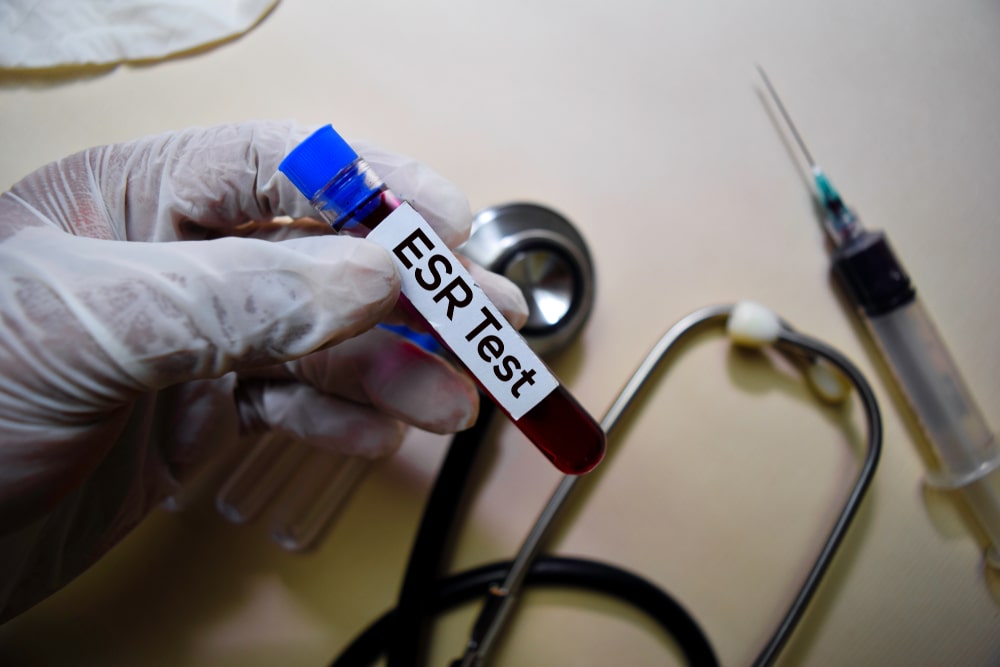Aim: To determine Erythrocyte Sedimentation Rate (ESR) by Wintrobe’s method.
Requirements: Blood sample, EDTA (or any other suitable anticoagulant), Wintrobe’s tube with stand, sterile disposable needle (26G), cotton swab, 70% alcohol, or any other suitable marketed antiseptic, Pasteur pipette.

Wintrobe’s tube is an 11 cm long tube open at the top and closed at its lower end. It is graduated from 0-10 cm (100 mm) from above downwards on one side (used for ESR) and 10-0 cm on the other side [used for Packed Cell Volume (PCV) or Haematocrit] as shown in Fig.1.
Principle: The rate of settling or sedimentation of erythrocytes (i.e. RBCs) in an uncoagulated blood sample is called Erythrocyte Sedimentation Rate (ESR). Generally, the RBCs remain uniformly suspended in the circulating blood. When the sample of uncoagulated blood is allowed to stand, RBCs being heavier than plasma gradually sediment. The process of sedimentation occurs in three stages is as follows:
- Piling up RBCs like a stack of coins forming the ‘Rouleaux’ which is maximum in first 10-15 minutes.
- Sinking of heavy Rouleaux to the bottom of the tube in next 40-45 minutes.
- Packing of clusters of RBCs to the bottom of blood column in next 10-12 minutes.
- The ESR is recorded in terms of millimeters at the end of one hour. In general, the more the RBCs, the less will be the ESR value and vice-versa.
- ESR testing is not diagnostic but it helps to rule out the presence and progress of the disease.
Procedure:
- Take 0.2 ml of 2.5% EDTA solution in the blood sample tube.
- Draw 0.2 ml of venous blood with the help of an expert technician and transfer it into the tube containing EDTA.
- Mix the contents gently but thoroughly by inverting the tube 2-3 times. Avoid vigorous shaking as it may form foam.
- Fill the Wintrobe’s tube with blood slowly using a Pasteur pipette up to the ‘0’ mm mark without any air gap.
- Transfer this Wintrobe’s tube to the stand and adjust the spirit level of the stand to ensure that the tube is exactly vertical.
- Keep the tube undisturbed in this position for one hour and strictly avoid tilting the tube.
- Read the ‘mm’ of clear plasma above the sedimented RBCs after 10, 50, and 60 minutes.
- Note the reading at 60 minutes as ESR 1st hour.
Normal ESR range (1st hour):
- Males: 2-8 mm.
- Females: 4-10 mm.
Observation:
- Name:
- Age:
- Gender:
- Date of recording:
| Sr. No. | Time (Minutes) | Length of clear plasma above the sedimented RBCs (mm) |
| 1. | 10 | |
| 2. | 50 | |
| 3. | 60 |
Result: ESR of the blood sample was found to be …… mm 1st hour.
Clinical Significance:
The ESR is a simple non-specific screening test that is used for the diagnosis of the following indications.
| Sr. No. | ESR | Indications/Factors responsible |
| 1. | Increased | Anemia, menstruation, hypo/hyperthyroidism, acute hepatitis, Macrocytosis, Leukemia, drugs (Penicillamine Procainamide Theophylline, Vitamin A), heavy metal poisoning, Diabetes mellitus, renal failure |
| 2. | Decreased | High level of albumin, polycythemia, congestive heart failure, Drugs (ACTH, Corticotropin, Cortisone, Ethambutol, Quinine, Salicylates), Cachexia, Thalassemia |
The ESR can be affected by three parameters:
- Abnormal RBCs, RBC size (microcytes, macrocytes) red cell mass, electrical charges, and zeta potential on the red cells.
- Plasma concentration and viscosity.
- Mechanical/technical factors like vibration, sunlight, inappropriate anticoagulant, improper mixing, sample collection time (within 1 hour after collection of a blood sample), age, sex, method of experiment, temperature condition, position, and diameter of the column during the experiment.
Make sure you also check our other amazing Article on : Estimation of Haemoglobin Content
